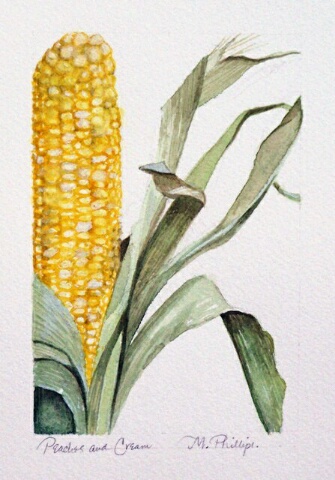August 4
(with permission of the artist)
Sweet Corn
by Barbara Schock
This is the time of year when people eat corn on the cob. It might be cooked for three to five minutes in boiling water or grilled over a charcoal fire. Some apply plenty of butter before eating and others like chili pepper sprinkled on the kernels.
Growing up in a prairie town Carl Sandburg was very familiar with fields of corn growing all around Galesburg. His mother may have prepared what was called green corn by removing the husk and silk and placing it in boiling water. Cookbooks published in the nineteenth century suggest boiling the ears of corn for 10 to 20 minutes. These directions may have applied to field corn which was harvested before it was completely ripe.
Corn and beans were cooked together with butter and salt. The dish was called succatash. Corn oysters were made by cutting the kernels from the cob and mixing them with a beaten egg, a little flour and salt and pepper. The batter was cooked on a hot, greased griddle. Corn pudding was made with the kernels cut from the ear, combined with eggs, cream and butter and baked in a casserole.
Humans have been eating corn for about ten thousand years. The tall grass ancestor first appeared in Mexico. It became so important in the diet of the natives, it was included in their religious practices and called “Mother Corn.”
Those native Americans used corn to make medicines for various ailments. They wove the leaves into mattresses for sleeping, baskets and moccasins. Many of the early European explorers discovered the food and its uses when they reached this hemisphere.
The Pilgrims probably would have starved if the Native Americans had not shown them how to grow and prepare corn for food. Corn contains a number of B vitamins, protein, carbohydrates and dietary fiber. The Pilgrims called it Indian corn to distinguish it from other grains. In England wheat seeds were known as corn.
Sweet corn is a natural mutation of field corn and has more sugar in the kernels. It is picked at the milk stage of maturity before the kernels become tough and starchy. The first sweet corn was grown in Pennsylvania in the 1700s.
In this country, we consume about 8 pounds of sweet corn per person per year. Much of the sweet corn crop is canned or frozen so we can enjoy it the year around. Since the 1950s corn geneticists at the University of Illinois and other research institutions have developed super-sweet corn and by-color corn for consumers. These hybrids stay fresh longer and can be purchased in grocery stores and roadside stands during the season. We are fortunate so much sweet corn is grown in the Midwest.
Carl Sandburg closed his poem Prairie with this line: “I am a brother of the cornhuskers who say at sundown: Tomorrow is a day.” The complete poem was published in Poetry Magazine in July 1918.
